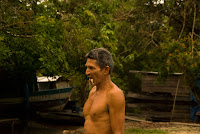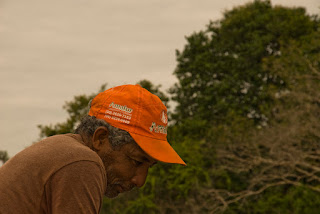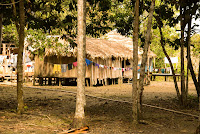Carlito and Guri quickly leave us behind. Our canoe is heavy with 11 persons on it.
Divan commands the motor in the back with Chris. Michael and Ebbe sit on the wooden bench just in front of them, behind the bulge of bags, equipments and supplies. Cathleen, Nicole and Matteo share the bench to the front and the botanists and I sit with Chico at the front. I have a pan full of salted piranhas between my feet, our dinner for the first night because we'll have no time to stop for fishing.
 At a slow pace we pass the forested borders of the wide rio Jauaperi. The girls are hungry, they haven't had breakfast having waited on the other side of the lake and soon start to 'attack' our provisions together with the botanists...if we continue on this pace, we'll have no food left for the rest of our trip..
At a slow pace we pass the forested borders of the wide rio Jauaperi. The girls are hungry, they haven't had breakfast having waited on the other side of the lake and soon start to 'attack' our provisions together with the botanists...if we continue on this pace, we'll have no food left for the rest of our trip..Sweet coffee from a red vacuum flask is passed on all over the canoe. I take care of seu Chico's needs, he seldom asks for something but never says no to anything I offer to him.
After some hours we turn left into the mound of the rio Xiparinã. The river is narrower than the former one and the vegetation on the riverbanks becomes gradually lower. The sun is high up in the sky, it must be around midday, but in fact I have already lost the perception of time.
The river winds up in endless curves, on our left side there seems to be high canopy that looks like firm land to me, but it isn't. It's just tall trees raising up from the waters.
Near the mound of the Xiparinã there is a small stilted house on the left bank of the river. We see Carlito and Guri's canoes lying on the shore, they must have stopped for a coffee, or some lunch. It's the home of Dona Odete, an old woman with a peculiar character who lives there all alone. The legend says Dona Odete had two husbands, when both died she sometime found a third one but it didn't work and so she just continued living there on her own. She thinks she is the owner of the river...
We proceed without Carlito and Guri, our canoe is much slower and it will be easy for them to catch up. After two riverbends a small canoe approaches us, Dona Odete sent out her nephew to get seu Chico. She wants to talk to him, probably to enquire where we are going. We see them disappear behind the riverbend and continue on our own.
Soon we get lost...Divan doesn't know the way but insists on proceeding, incited by the boys. They have a GPS in their equipment, but don't really know how to use it...
Then the motor starts to make strange noises and stops. Divan shouts 'o rabo, o rabo' (the 'tail'), the small tail that moves the rabeta motor has broken off and here we find out that we have no tools on board...
There we are, under a burning sun in the middle of nowhere. The reserve motor is on Carlito's canoe but there is no sign of them.
Divan and Chris start to row back (I'm not so sure they know the direction...it looks as if we are proceeding in circles), in the hope to catch up with the other men. Stefan at some point manages to get through to the map on the GPS where his tutor from INPA had marked some points on the way to the buritizal and says that we are on the right direction.
We try to concentrate on the sounds carried by the water, hoping to hear the crackling noise of Carlito's motor. Nothing. The silence is broken only by Divan's desperate gibberish and some lonely bird's cry. Mike and Ebbe don't look very comfortable and I try to avoid their glances.
Nature around us is gorgeous by the way, it's not a bad place to get lost...
After what seemed an eternity our men reappear and Chico jumps into our canoe. Together with Divan he has a look at the motor, but without tools it's not possible to repair it, not in a short time. The 'Severino' is called to action, but it's obvious even to me that it's a far to weak motor to push the heavy canoe. We proceed very slowly now.
From time to time Divan shouts from the back that the motor has lost a screw, he is holding with both arms the motor because it doesn't fit well on the canoe and he's sweating like hell.
 It must be mid afternoon already and dark clouds are building up on the horizon. Our folks are hungry but the only land strip we find is a steep mud embankment and we decide to push forward, eating some crackers from our supplies. Carlito and Guri deny the snacks, I'm told that they only eat 'warm' cooked food...I suppose they must have eaten something at Dona Odete's - but they never admitted it..
It must be mid afternoon already and dark clouds are building up on the horizon. Our folks are hungry but the only land strip we find is a steep mud embankment and we decide to push forward, eating some crackers from our supplies. Carlito and Guri deny the snacks, I'm told that they only eat 'warm' cooked food...I suppose they must have eaten something at Dona Odete's - but they never admitted it..From the open river we enter the submerged forest. Here the hard work begins and we get a taste of what the next days will be. The motors are taken off to avoid their getting stuck in the vegetation. From now on we depend on the paddles. Carlito and Guri on their slim canoes go in front cutting through branches and fallen trees. Chico clears the way for the big canoe - a difficult task, because it's broad 'womb' keeps getting stuck between the trunks that stick out of the water. Some of us try to help out by paddling and pushing the canoe along the steep passages between the trees.
Chris looks worried at the rapidly darkening sky, we are still far from the first land strip we're supposed to reach for the night and it looks as if it's going to rain soon.
Chico is indefatigable, he cuts vigorously small, big, soft and hard trees, always turning back to look at us with a big smile when he gets through. He balances up and down barefoot on the slim borders of the canoe, sometimes loosing his balance causing me to grab his hand or his leg to get him back into the boat. He ends up cutting his finger badly with the ax and as we have no gloves on board I give him one of my socks to put on his hand.
Under the rain we arrive at the land strip. It's almost dark and Chico, Guri, Divan and Carlito after anchoring the canoes quickly penetrate into the forest. In no time at all they open a clearance, cut thick trunks and put up the blue tarpaulin under which we hang our hammocks.
Exhausted we all climb into the hammocks and not even the youngsters in our group have the courage to say that they are hungry. Soon silence broken only by the rain pounding on the tarpaulin gets over the camp.
My first night in the forest...I fall in a deep sleep, lulled by the rocking hammock.
In the middle of the night I wake up just to see that the rain has stopped and Chico, Guri and Carlito have moved out from under the tarpaulin and are now sleeping in the open. I promise to myself to do the same tomorrow.








































